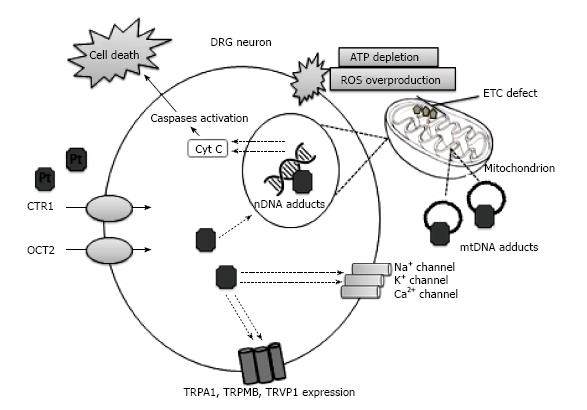Copyright
©The Author(s) 2017.
World J Clin Oncol. Aug 10, 2017; 8(4): 329-335
Published online Aug 10, 2017. doi: 10.5306/wjco.v8.i4.329
Published online Aug 10, 2017. doi: 10.5306/wjco.v8.i4.329
Figure 1 Proposed mechanisms of platinum-induced neurotoxicity.
Dorsal root ganglion (DRG) is the main target of platinum drugs that preferentially accumulate in DRG neurons. Membrane transporters, copper transporter-1 (CTR1) and organic cation transporter-2 (OCT2), can facilitate the cellular uptake of platinum drugs. Platinum-DNA adducts inhibit replication and transcription, which results in caspase activation and subsequent cell death. Neuronal mitochondrial damage leads to cellular ATP depletion and increased reactive oxygen species (ROS) production. The voltage-gated sodium (Na+), potassium (K+) and calcium (Ca2+) channels dysfunction, and the enhanced expression and responsiveness of transient receptor potential channels (TRPA1, transient receptor potential ankyrin-1; TRPM8, transient receptor potential melastatin 8; TRPV1, transient receptor potential vanilloid 1) play an important role in the development of platinum-induced neurotoxicity.
- Citation: Kanat O, Ertas H, Caner B. Platinum-induced neurotoxicity: A review of possible mechanisms. World J Clin Oncol 2017; 8(4): 329-335
- URL: https://www.wjgnet.com/2218-4333/full/v8/i4/329.htm
- DOI: https://dx.doi.org/10.5306/wjco.v8.i4.329









